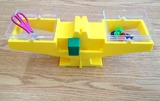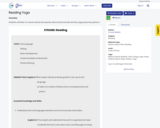
Balancing Act Equality Mathematics Instructional Plan
- Subject:
- Mathematics
- Material Type:
- Lesson Plan
- Provider:
- VDOE
- Author:
- VDOE
- Date Added:
- 10/04/2024

Balancing Act Equality Mathematics Instructional Plan

Video lesson intended for grades 3-5 with a mindfulness moment, warmup, instruction and practice of basic balance and transfer of weight movements, and a sequence of two movements. Video is 15:48 minutes in length.Video created by Virginia's Chief Movement Officers cadre in collaboration with Focused Fitness, Virginia Department of Health, and Virginia Department of Education.

This video is part of the Learn and Grow with WHRO TV series. Watch Xenia Clare teach about strategies to determine equality in equations.

This resource is a remix from Illustrative Mathematics (https://goopenva.org/courses/3-md-how-heavy). This resource encourages student collaboration and allows students to have a mathematical dialogue as express their understanding of units of measure. Teachers can use objects found around the house to demonstrate mathematics in the real world. I like how this resource adds flexibility in instruction, as it allows teachers to creatively add diverse manipulatives or real-life items on the balance scale. This activity scaffolds the learning process allowing students an opportunity to experience active hands-on learning to strengthen their understanding of mathematical concepts, which provides a diverse learning experience. This resource is a valuable part of building background when introducing units of measure or equations in the early elementary years of mathematics education as it provides students a concrete example of building an equation with concrete objects. Suggested Modification - A student recording sheet with illustrations has been added to the resource to allow all different types of learner to learn from a concrete idea to strengthen conceptual learning about building an equation.

Video Description: Earth's energy balance is very delicate. Small changes may have a big impact. How might changes in Earth's land and atmosphere impact this delicate balance? How might this knowledge be used to help us take better care of Earth? Video Length: 2:31.NASA eClipsTM is a suite of online student-centered, standards-based resources that support instruction by increasing STEM literacy in formal and nonformal settings. These free digital and downloadable resources inform and engage students through NASA-inspired, real-world connections.NASA eClips Real World segments (grades 6-8) connect classroom mathematics to 21st Century careers and innovations. They are designed for students to develop an appreciation for mathematics through real-world problem solving.

Students will listen to a book read by the teacher about forest animals and the yoga poses they perform.